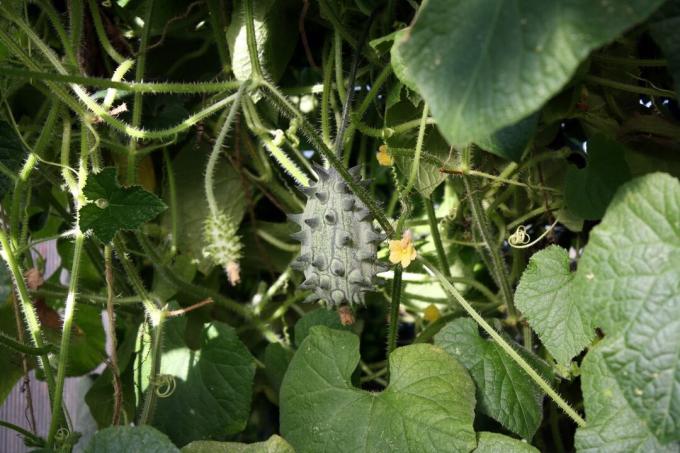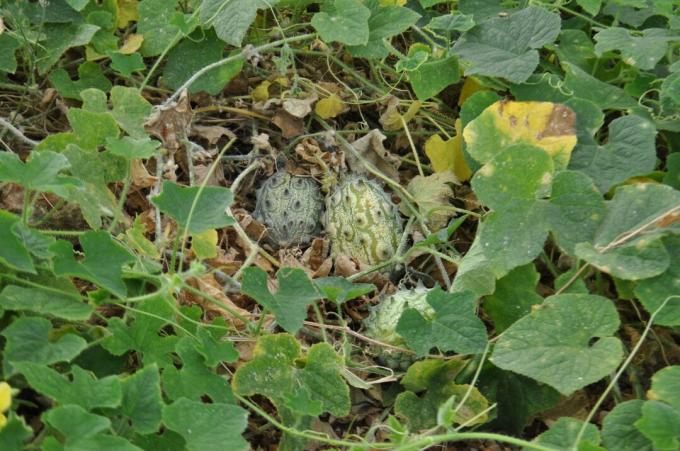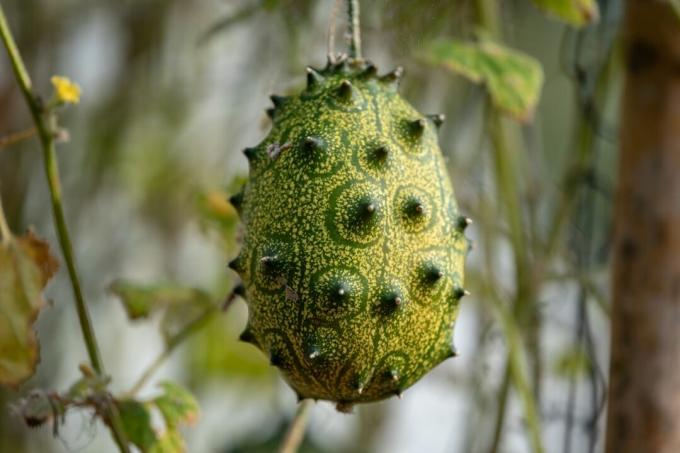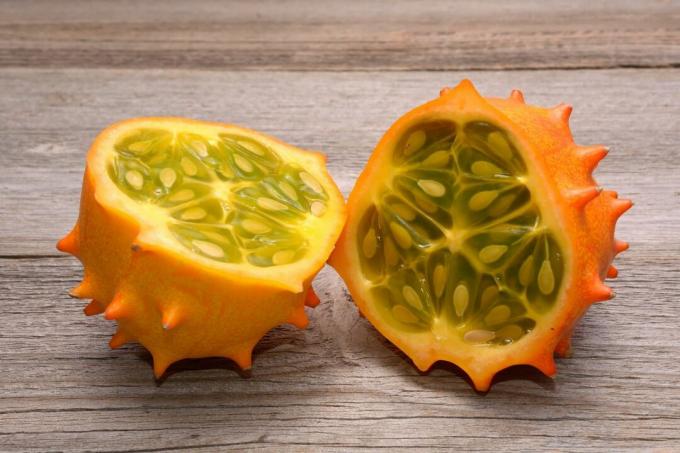Despite the exotic name, the Kiwano is an easy-care, robust one Garden plant that usually thrives in warm locations without any problems and provides us with long-storage fruits rewarded.

Not only in the Latin name of Kiwano (Cucumis metuliferus) shows the similarity of this exotic fruit with the one we know cucumber (Cucumis sativus). There are also certain similarities between the two plants in terms of site requirements and growth behavior. In contrast to cucumbers, however, the African prickly cucumber is significantly less susceptible to disease and its fruits can be stored for up to 9 months. If you want to grow Kiwanos yourself, a warm location is particularly important. In this article we explain what else you should consider when planting horned cucumbers, what is involved in the care of Kiwanos and how to eat a Kiwano.
contents
- Kiwano: origin and characteristics
- Plant kiwano
- Proper care of the horned cucumber
- Harvest Kiwanos
- How do you eat a Kiwano?
- Flavor of Horned Cucumber
- Is the Kiwano healthy?
Kiwano: origin and characteristics
There are many synonyms for the Kiwano: African horned cucumber, jagged cucumber or horned melon are just a few examples. Kiwanos or prickly cucumbers are a somewhat more unusual representative of the pumpkin family (Cucurbitaceae), which is still unknown to us. The origin of the Kiwano lies in the savannah regions of the Kalahari in South Africa. It was first cultivated in New Zealand and Israel, from where the Kiwano is now slowly finding its way into our German gardens.

The Kiwano is an annual, warmth-loving climbing plant whose shoots can grow up to 3 m long. The heart-shaped leaves with a diameter of up to 14 cm resemble those of the cucumber. Since Kiwanos is about monoecious plants both female and male flowers are found on a kiwano plant. Both are rather small, inconspicuous and yellow in color. From the ovaries of the female kiwano flowers, which are a good distinguishing feature, larger and larger fruits develop relatively quickly, the skin of which is covered with large spines.
Botanically, kiwanos are berries because their numerous seeds are embedded in the gelatinous, greenish flesh. Kiwanos can reach a size of up to 12 x 16 cm, but usually stay a little smaller. As the kiwano ripens, the color changes from green to yellow-orange. The interior, on the other hand, remains greenish.

Plant kiwano
Kiwanos need a lot of warmth and need constant temperatures above 15 °C for good growth. For this reason, growing Kiwanos outdoors should only be done in warm, sheltered locations, such as in front of a south-facing house wall. Otherwise, it is better to cultivate horned cucumbers in the greenhouse. Apart from that, Kiwanos like to stand in the sun and prefer loose, well-drained, nutrient-rich and evenly moist soil.
Tip: When growing Kiwanos in a pot, a sufficiently large container with at least 20 liters capacity should be chosen. Ours is a suitable substrate, for example Plantura organic tomato & vegetable soil. It is already pre-fertilized and is therefore perfect for vegetables with a higher nutrient requirement. In addition, it does not require any peat at all and is sustainably produced in Germany.

Plantura organic tomato & vegetable soil
Organic, peat-free & climate-friendly:
For all types of vegetables and berries,
ensures a rich and aromatic harvest, harmless to humans and animals
Due to the high need for warmth, growing Kiwanos indoors is a good idea. In this way, when the plants come into the garden in May, they already have a head start in growth. Sowing the seeds of horned cucumbers should be done no earlier than mid-April, as the seedlings develop quite quickly in warm temperatures and must not be too large when planted in the bed come.
- Fill pots of about 10 cm in diameter with a nutrient-poor potting soil. For example, we recommend our Plantura Organic Herb & Seed Soil.
- The substrate is slightly moistened. Then plant 2 to 3 kiwano seeds per pot about 1 to 2 cm deep in the soil.
- Place the pots in a bright place and make sure that the substrate never dries out. At an optimal germination temperature of 22 to 24 °C, the first seedlings should be visible after 1 to 2 weeks.
- The seedlings should now be cultivated in a bright place at at least 20 °C and watered regularly. It is advisable to add an organic liquid fertilizer like ours to the irrigation water about once a week Plantura Organic Tomato & Vegetable Fertilizer to mix in
- If more than one kiwano seed germinates per pot, leave only the strongest seedling and discard the rest.

In mid-May, when the outside temperature is above 15°C, it is time to plant the horned cucumbers. Before doing so, harden the young plants well by placing them outside in the sun for several hours a day. Before you plant the Kiwanos, you should prepare the soil well by loosening it and weeding it. Since horned cucumbers do not tolerate waterlogging at all, a light ridge culture is even an option. In addition, the ground there also warms up better. Growing Kiwanos requires a lot of space. Keep a distance of at least 1 m between the rows and 50 to 60 cm within the row. After planting, the Kiwanos are watered well.
Proper care of the horned cucumber
The cultivation of horned cucumbers works better if you offer the plants a trellis, similar to that used for cucumbers. Then they grow more luxuriantly and form more fruits that are less dirty.

Regular watering and fertilizing are key to caring for Kiwanos.
During the summer it may even be necessary to reach for the watering can every day. It is best to use warm water. This can be achieved, for example, by refilling the watering can immediately after watering and leaving it in a sunny place until the next day. To conserve water and protect the soil, it is a good idea to plant around the kiwano plants mulch. Lawn clippings, for example, are well suited because they also provide nutrients.
Like cucumbers, African prickly cucumbers are heavy feeders. This means that a well-prepared bed with compost alone is usually not enough to achieve good yields. We recommend ours for fertilizing during the growing season, about once a week Plantura Organic Tomato & Vegetable Fertilizer to mix with the irrigation water. It has an optimal nutrient ratio for heavily consuming vegetables. It's also completely animal-free and primarily organic. Therefore, in contrast to mineral fertilizers, it also promotes a healthy soil.

Plantura Organic Tomato & Vegetable Fertilizer
Highly effective organic liquid fertilizer
with an NK ratio of 4-5
for all types of vegetables & berries,
safe for pets and garden animals
Grooming or cutting the Kiwano is not absolutely necessary. If you have enough space, you can simply let the plant grow and climb and only remove disturbing shoots. If you have less space, you can, for example, grow Kiwanos in two shoots in the greenhouse and they like Pick cucumbers.
Tip: Kiwanos are significantly less susceptible to disease than cucumbers, for example. Even the wrong one mildew (Peronosporaceae) very rarely affects horned cucumbers.
Harvest Kiwanos
If you grow African prickly cucumbers, you can usually look forward to a bounty harvest. Up to 50 fruits per plant are possible, with Glasshouse on average, a little more is harvested than outdoors. Harvest time for the Kiwanos begins around mid-August. The optimal harvest time can be recognized by the fact that the fruits are just beginning to change color from green to orange-yellow. In order for the horned cucumber to deliver longer and higher yields, the fruits are harvested before they are fully ripe and then left to ripen a little longer indoors. This stimulates the plant to bloom more. Horned cucumbers can be harvested regularly well into autumn. The last ones should be brought indoors at the latest before the first frost to ripen.
Since the fruits are really prickly, it is advisable to wear gloves when picking them. In addition, pruning shears for cutting the fruit make the work much easier. Be careful not to leave the stalk attached to the fruit. This way it can be stored longer.
Since the fruits are harvested when they are still green, you should be patient before eating them and let them ripen indoors at room temperature. They can even be stored for 6 to 9 months in a slightly cooler place at around 9 °C. However, you should never put the fruit in the refrigerator, because it spoils relatively quickly there.

Tip: Even if it seems easy at first to collect the seeds of the Kiwano and sow them again in the spring, there can be nasty surprises with the next harvest. Like other gourds, kiwanos can become bitter and therefore poisonous. The probability of this increases through self-reproduction. Since cucurbits are cross-pollinators and also like to crossbreed with each other, you should have at least two kiwano plants close together and, above all, no cucumbers nearby. Both belong to the genus Cucumis and crossing of the two species can therefore easily occur. Hand pollinating the female flowers increases the chance of harvesting pure kiwan seed. In order to be able to obtain viable seeds, the fruit must be allowed to fully ripen on the plant.
How do you eat a Kiwano?
To eat, kiwanos are cut in half either lengthwise or crosswise, and then scooped out. The numerous seeds in the pulp can simply be eaten. Instead of eating them directly, Kiwanos can also be used to prepare cocktails, salads or sorbets, for example. You can also squeeze juice from Kiwanos. A simple method is to put the hollowed-out pulp in a cheesecloth or a fine kitchen towel and squeeze it out with your hands.
Tip: When using kiwanos to make desserts, the hollowed-out bowls make fancy, decorative serving dishes.

Flavor of Horned Cucumber
The taste of Kiwanos depends on the degree of ripeness. If the fruits are still green and freshly harvested, their taste is actually reminiscent of cucumbers. As they mature, their flesh becomes sweeter, giving the flavor of Kiwanos that have been stored for some time and have a more yellow-orange skin than described as a mix between melon, banana and lime.
Is the Kiwano healthy?
The main ingredient in kiwanos is water - similar to cucumbers. This makes them a very figure-friendly vegetable. For example, although the ingredients in Kiwanos include vitamins B and C, their vitamin content is generally relatively low. Despite this, the fruits of the kiwano are very healthy as they are rich in magnesium, potassium and iron and contain some antioxidants.

If you like growing some fancy veggies that you can't find in every supermarket, why not give it a try tattoo (Brassica rapa convar. narinosa). The leafy vegetables, which can also be grown well in autumn when the temperatures are cooler, grow quickly and are suitable for Asian dishes, for example.
...and receive concentrated plant knowledge and inspiration directly in your e-mail inbox every Sunday!



